Sold Ceramics
Sold Shipwreck Porcelains
The Diana Cargo 1817
Page 1
The Diana Cargo
1817
'The Diana' was owned by Palmer and Co. a powerful Calcutta ship owner and was liscenced
by the English East India Company to sail from Calcutta or Madras to Canton, carrying cotton
and of course, opium, which was extremely lucrative. The ship would then return to India from
China, laden with silks, tea, preserved fruits and thousands of pieces of beautiful blue and white
porcelain.
Unfortunately The Diana was on one of these voyages when, on the 14th of March 1817, she hit
some rocks off the Straits of Malacca and sank. The wreck was identified and recovered in 1994
by Dorian Ball of Malaysian Historical Salvors.
Christie's auctioned the porcelain cargo in Amsterdam in March 1995.
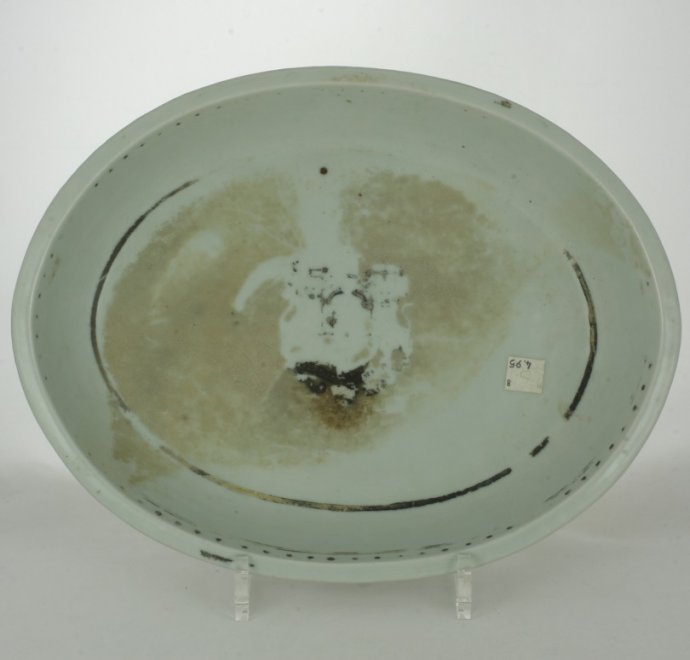
Sold Ceramics - Sold Shipwreck Porcelains - The Diana Cargo, 1817 - Page 1
Object 2010534
Armorial small deep dish for the official dinner service of the "Honourable East India Company", apparently in the shipment as additional pieces for the service used on formal occasions at the President's residence in Madras.
China
c.1816
Provenance: The Diana Cargo sale, Christie's Amsterdam, 6-7 March 1995
Height 52 mm (2.05 inch), dimensions rim 310 mm x 240 mm (12.20 inch x 9.45 inch), dimensions base 245 mm x 175 mm (9.65 inch x 6.89 inch), weight 949 grams (33.48 ounce (oz.))
Small 'Honourable East India Company' Armorial oval dish, spreading sides and an unglazed base. Decorated in polychrome enamels and gold with in the centre two lions rampant bearing standards and flanking a crested coat-of-arms above the motto 'Auspicio Regis et Senatus Anglia', The broad everted rim with a point-and-pendulum border. On base the original 'Christie's Diana Cargo March 1995' auction sale lot 495/8 label proving it has been one of 8 similar Armorial small deep dishes sold in lot 495.
All the enamels have been eroded by the sea, never the less the outlines of the original decoration are still visible in ghost form.
The arms are those of the New East India Company; Argent a cross gules in dexter chief quarter an escutcheon with the arms of Great Britain (1 & 4 England, 2 Scotland, 3 Ireland), The shield ornamented and regally crowned or. Crest: on a wreath argent and gules a lion rampant gardant or holding between the forefeet a royal crown proper. Supporters: two lions rampant gardant or each supporting a banner erect charged with a cross gules. The New East India Company was united with the older East India Company in 1709. It is quite likely that this service was originally commissioned, for the exclusive use of the Presidents at "John Company" functions in the Madras and Bombay Residencies, on the occasion of the centenary of the original merger between the "Old" and the "New" Companies. This service was used in Bombay and Madras, from where various Governors took parts of the service back to England (Amsterdam 1995)
In total 180 small enamelled "Honourable East India Company" Armorial Oval Dishes were sold, 136 of 305 mm (12.00 inch) , 22 of 310 mm (12.20 inch) and 22 of 350 mm (13.78 inch) divided over the lots: 449-496. (Amsterdam 1995)
For an oval dish or stand decorated in famille rose enamals with the same arms of the New East India Company, please see:
Condition: Perfect.
References:
Price: Sold.
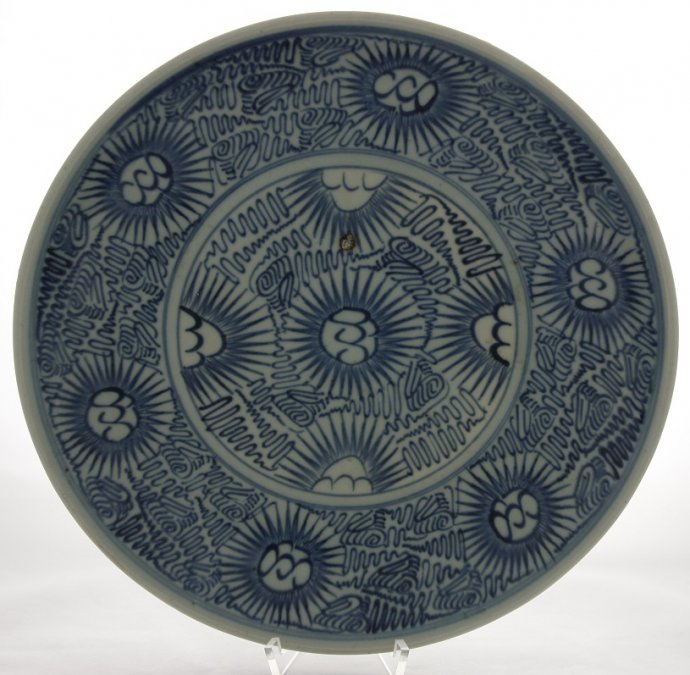
Sold Ceramics - Sold Shipwreck Porcelains - The Diana Cargo, 1817 - Page 1
Object 2010137
Dish
China
c.1816
Provenance: The Diana Cargo sale, Christie's Amsterdam, 6-7 March 1995
Height 60 mm (2.36 inch), diameter of rim 280 mm (11.02 inch), diameter of footring 165 mm (6.49 inch), weight 778 grams (27.44 ounce (oz.))
Dish on footring, straight rim and an unglazed base. Decorated in underglaze blue with in the centre and sides a dissolved chrysanthemum design, comprising full blooms alternating with pairs of solved conch shells. On the reverse four floral sprays. On the base the original 'Christie's Diana Cargo March 1995' sale lot 649/24 label proving it has been one of 24 similar dishes sold in lot 649.
The design on this dish is known as the 'Starburst' pattern. In total 4,630 dishes with the 'Starburst' pattern, in various sizes were sold divided over the lots: 374-416, 434-436, 437, 618-673, 1188-1198, 1210-1223, 1236-1252, 1256-1277, 1280-1283 & 1289-1295. (Amsterdam 1995)
Condition: Perfect.
References:
Price: Sold.
More pictures object 2010597, another identically shaped, sized and decorated, sold dish >>
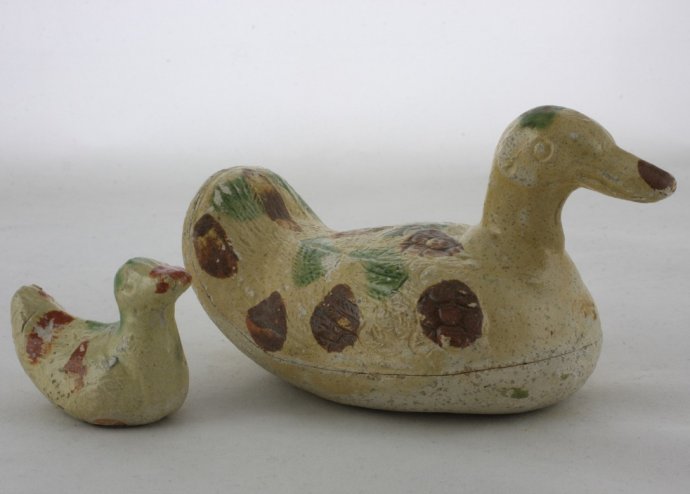
Sold Ceramics - Sold Shipwreck Porcelains - The Diana Cargo, 1817 - Page 1
Objects 2011186 and 2011191
A glazed toy duck and toy duckling
China
c.1816
Mark: Shop/makers mark on the belly of large duck.
Provenance: The Diana Cargo sale, Christie's Amsterdam, 6-7 March 1995
2011186: height 67 mm (2.79 inch), dimensions 123 mm (4.84 inch) x 65 mm (2.56 inch)
2011191: height 37 mm (1.46 inch), dimensions 43 mm (1.69 inch) x 29 mm (1.14 inch)
Glazed toy duck and duckling each moulded with naturalistic legs, wing and tail feathers and impressed circular eye, under a straw glaze with scattered green and brown spots. Marked on the belly of large duck. with a shop/makers mark: 陶 = Pottery. (not ceramic) and 合 = combine; being together; close. (source: S. Fan) On both toy duck and toy duckling the original 'Christie's Diana Cargo March 1995'' sale lot 942 label proving they have been two of four toy ducks and four toy ducklings sold in lot 942.
Ball states that of the 877 terracotta statues, animal statue predominated. There were crowing cocks, seated dogs, paddling ducks, horses and buffalo. The finest one of all was the boy on a buffalo. Amazingly, the paint had survived on many of them and apart from their desirability for reasons of religion or superstition, they would make attractive display pieces too. The objects were especially popular with the more superstitious southern Chinese communities in Guandong, Fujian, and Zhejiary provinces; and little secular groups. Figures were normally carried as "private" cargo, not in bulk; but there is evidence that there were several hundred on Diana, so maybe the Madrassi principals thought it was worth experimenting with the local markets in India. The Chinese never regarded ceramic sculptures as a serious art form. Unlike Western potters, who were excited by trying to recreate in a ceramic medium the achievements of the European stone and wood sculptural tradition, the Chinese made pottery and porcelain figures as a very cheap substitute only for other media like stone, wood or even ivory and soapstone) in Fujian province'. Ceramic figures never formed the bulk part of a cargo coming back from the West+ except for a brief period a century before Diana, when blanc de Chine figures became sufficiently popular for large quantities to be shipped from a temporary entrepôt at Amoy. Apart from that moment, Diana tells us, more than any other excavated ship's cargo, about what figures the Chinese were producing, and what was popular abroad even when largely divorced from their original context. (Ball 1995, pp.145-149)
In total 74 glazed toy ducks and 88 glazed toy ducklings were sold divided over the lots: 919-944. (Amsterdam 1995)
Condition: The duck has a chip to the tip of her beak, the duckling has some minor firing flaws.
References:
Price: Sold.
More pictures of object 2011186 >>
More pictures of object 2011191 >>
More pictures of object 2011187 >>
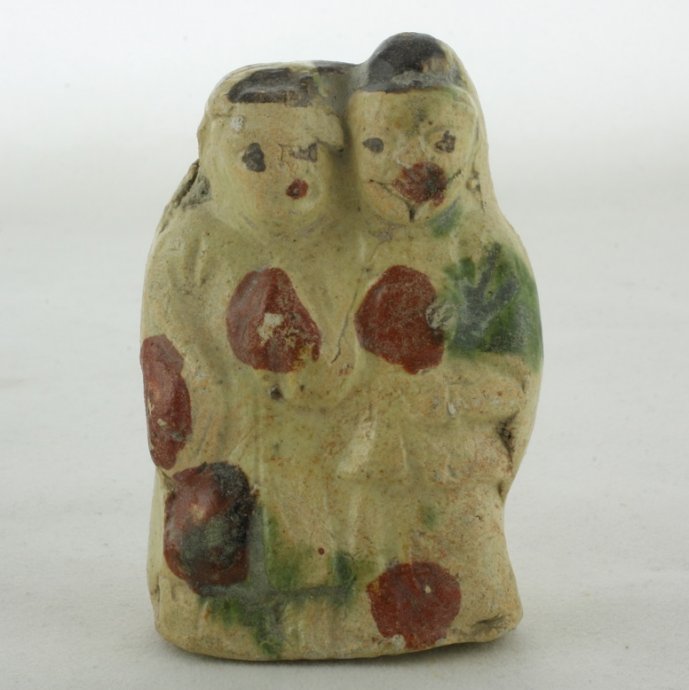
Sold Ceramics - Sold Shipwreck Porcelains - The Diana Cargo, 1817 - Page 1
Object 2011035
Glazed toy figure
China
c.1816
Provenance: The Diana Cargo sale, Christie's Amsterdam, 6-7 March 1995
Height 60 mm (1.46 inch), dimensions 39 mm (1.69 inch) x 22 mm (1.14 inch)
Glazed toy figure of a 'happy couple' straw glazed with scattered green and dark spots. On the toy figure the original 'Christie's Diana Cargo March 1995' sale lot 1009/10 label proving it has been one of 10 toy figures sold in lot 1009.
Ball states that of the 877 terracotta statues, animal statue predominated. There were crowing cocks, seated dogs, paddling ducks, horses and buffalo. The finest one of all was the boy on a buffalo. Amazingly, the paint had survived on many of them and apart from their desirability for reasons of religion or superstition, they would make attractive display pieces too. The objects were especially popular with the more superstitious southern Chinese communities in Guandong, Fujian, and Zhejiary provinces; and little secular groups. Figures were normally carried as "private" cargo, not in bulk; but there is evidence that there were several hundred on Diana, so maybe the Madrassi principals thought it was worth experimenting with the local markets in India. The Chinese never regarded ceramic sculptures as a serious art form. Unlike Western potters, who were excited by trying to recreate in a ceramic medium the achievements of the European stone and wood sculptural tradition, the Chinese made pottery and porcelain figures as a very cheap substitute only for other media like stone, wood or even ivory and soapstone) in Fujian province'. Ceramic figures never formed the bulk part of a cargo coming back from the West+ except for a brief period a century before Diana, when blanc de Chine figures became sufficiently popular for large quantities to be shipped from a temporary entrepôt at Amoy. Apart from that moment, Diana tells us, more than any other excavated ship's cargo, about what figures the Chinese were producing, and what was popular abroad even when largely divorced from their original context. (Ball 1995, pp.145-149)
In total 212 glazed toy figures (of which 66 'happy couple' figures) were sold divided over the lots: 989-1013. (Amsterdam 1995)
Condition: Some loss of glaze due to to submergence in sea water.
References:
Amsterdam 1995, p.120, lot 989-1013
Price: Sold.
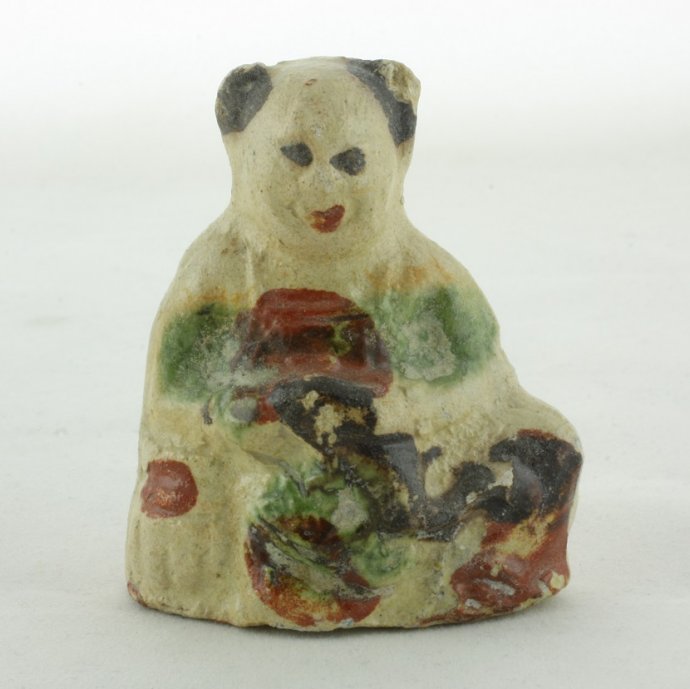
Sold Ceramics - Sold Shipwreck Porcelains - The Diana Cargo, 1817 - Page 1
Object 2010971
Glazed toy figure
China
c.1816
Provenance: The Diana Cargo sale, Christie's Amsterdam, 6-7 March 1995
Height 56 mm (2.79 inch), dimensions 49 mm (4.84 inch) x 32 mm (2.56 inch)
Glazed toy figure of a seated boy holding a bushy-tailed feline straw glazed with scattered green and dark spots. On the toy figure the original 'Christie's Diana Cargo March 1995' sale lot 1009/10 label proving it has been one of 10 toy figures sold in lot 1009.
Ball states that of the 877 terracotta statues, animal statue predominated. There were crowing cocks, seated dogs, paddling ducks, horses and buffalo. The finest one of all was the boy on a buffalo. Amazingly, the paint had survived on many of them and apart from their desirability for reasons of religion or superstition, they would make attractive display pieces too. The objects were especially popular with the more superstitious southern Chinese communities in Guandong, Fujian, and Zhejiary provinces; and little secular groups. Figures were normally carried as "private" cargo, not in bulk; but there is evidence that there were several hundred on Diana, so maybe the Madrassi principals thought it was worth experimenting with the local markets in India. The Chinese never regarded ceramic sculptures as a serious art form. Unlike Western potters, who were excited by trying to recreate in a ceramic medium the achievements of the European stone and wood sculptural tradition, the Chinese made pottery and porcelain figures as a very cheap substitute only for other media like stone, wood or even ivory and soapstone) in Fujian province'. Ceramic figures never formed the bulk part of a cargo coming back from the West+ except for a brief period a century before Diana, when blanc de Chine figures became sufficiently popular for large quantities to be shipped from a temporary entrepôt at Amoy. Apart from that moment, Diana tells us, more than any other excavated ship's cargo, about what figures the Chinese were producing, and what was popular abroad even when largely divorced from their original context. (Ball 1995, pp.145-149)
In total 212 glazed toy figures (of which 62 'seated boy with a bushy- tailed feline' figures) were sold divided over the lots: 989-1013. (Amsterdam 1995)
Condition: Some loss of glaze due to submergence in sea water and a frit to the head.
References:
Price: Sold.
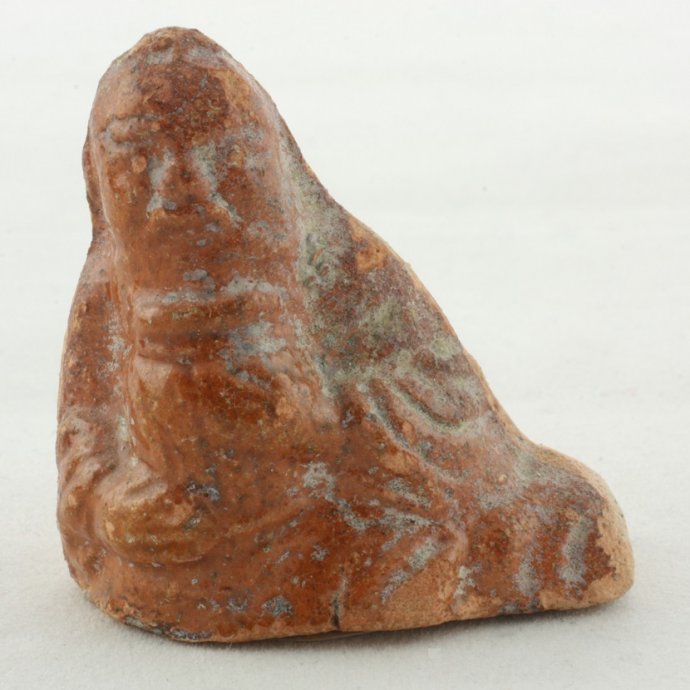
Sold Ceramics - Sold Shipwreck Porcelains - The Diana Cargo, 1817 - Page 1
Object 2010998
Glazed toy figure
China
c.1816
Provenance: The Diana Cargo sale, Christie's Amsterdam, 6-7 March 1995
Height 36 mm (1.42 inch), dimensions 38 mm (1.49 inch) x 14 mm (0.55 inch)
Toy figure, an amber-glazed, two-tone working whistle in the form of reclining, Li Bai the drunken poet. On the toy figure the original 'Christie's Diana Cargo March 1995' sale lot 1009/10 label proving it has been one of 10 toy figures sold in lot 1009.
Ball states that of the 877 terracotta statues, animal statue predominated. There were crowing cocks, seated dogs, paddling ducks, horses and buffalo. The finest one of all was the boy on a buffalo. Amazingly, the paint had survived on many of them and apart from their desirability for reasons of religion or superstition, they would make attractive display pieces too. The objects were especially popular with the more superstitious southern Chinese communities in Guandong, Fujian, and Zhejiary provinces; and little secular groups. Figures were normally carried as "private" cargo, not in bulk; but there is evidence that there were several hundred on Diana, so maybe the Madrassi principals thought it was worth experimenting with the local markets in India. The Chinese never regarded ceramic sculptures as a serious art form. Unlike Western potters, who were excited by trying to recreate in a ceramic medium the achievements of the European stone and wood sculptural tradition, the Chinese made pottery and porcelain figures as a very cheap substitute only for other media like stone, wood or even ivory and soapstone) in Fujian province'. Ceramic figures never formed the bulk part of a cargo coming back from the West+ except for a brief period a century before Diana, when blanc de Chine figures became sufficiently popular for large quantities to be shipped from a temporary entrepôt at Amoy. Apart from that moment, Diana tells us, more than any other excavated ship's cargo, about what figures the Chinese were producing, and what was popular abroad even when largely divorced from their original context. (Ball 1995, pp.145-149)
In total 212 glazed toy figures (of which 38 Li Bai figures) were sold divided over the lots: 989-1013. (Amsterdam 1995)
Condition: Some loss of glaze due to to submergence in sea water and a frit to the head.
References:
Price: Sold.
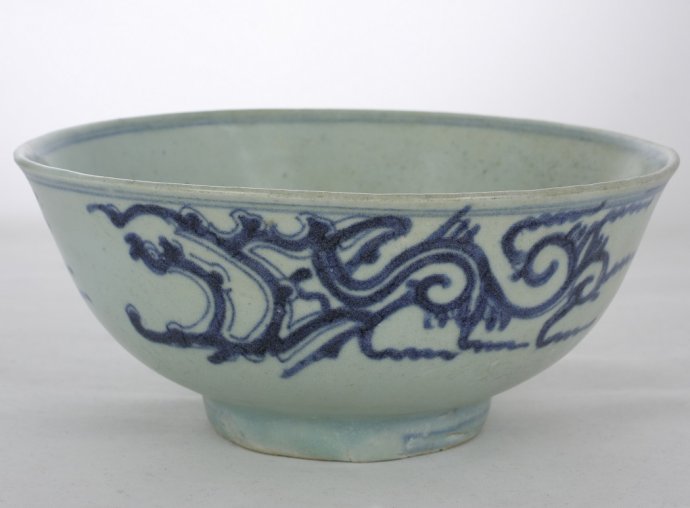
Sold Ceramics - Sold Shipwreck Porcelains - The Diana Cargo, 1817 - Page 1
Object 2010669
Bowl
China
c.1816
Provenance: The Diana Cargo sale, Christie's Amsterdam, 6-7 March 1995
Height 79 mm (3.11 inch), diameter of rim 175 mm (6.89 inch), diameter of footring 75 mm (2.95 inch), weight 412 grams (14.53 ounce (oz.))
Bowl on footring, straight sides and slightly flaring rim. Decorated in underglaze blue with writhing young chilongs (sea dragons) and flames. Marked on the base with a shop / seal mark, underglaze blue. On the bowl the original 'Christie's Diana Cargo March 1995' sale lot 1026/36 label proving it has been one of 36 similar bowls sold in lot 1026.
In total 1272 graduated 'dragon' bowls, in various sizes, were sold divided over the lots: 1014-1041 & 1158-1187. (Amsterdam 1995)
Condition: A firing flaw to the rim.
References:
Amsterdam 1995, lot 1014-1041 & 1158-1187
Price: Sold.
More pictures of object 2010138, another identically shaped, sized and decorated, sold bowl >>
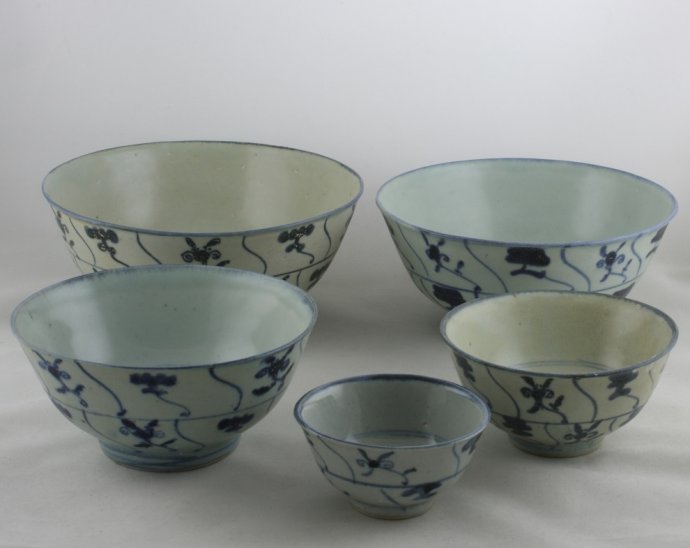
Sold Ceramics - Sold Shipwreck Porcelains - The Diana Cargo, 1817 - Page 1
Objects 2011771A/E
Five bowls
China
c.1816
Provenance: The Diana Cargo sale, Christie's Amsterdam, 6-7 March 1995
2011771A: height 81 mm (3.19 inch), diameter of rim 175 mm (6.89 inch), diameter of footring 70 mm (2.76 inch), weight 431 grams (15.20 ounce (oz.))
2011771B: height 75 mm (2.95 inch), diameter of rim 165 mm (6.50 inch), diameter of footring 65 mm (2.56 inch), weight 331 grams (11.68 ounce (oz.))
2011771C: height 70 mm (2.76 inch), diameter of rim 145 mm (5.71 inch), diameter of footring 60 mm (2.36 inch), weight 251 grams (8.85 ounce (oz.))
2011771D: height 57 mm (2.24 inch), diameter of rim 115 mm (4.53 inch), diameter of footring 40 mm (1.58 inch), weight 163 grams (5.75 ounce (oz.))
2011771E: height 45 mm (1.77 inch), diameter of rim 85 mm (3.35 inch), diameter of footring 30 mm (1.18 inch), weight 89 grams (3.14 ounce (oz.))
Five bowls on footrings, straight sides and slightly flaring rims. Decorated in underglaze blue with two tiers of interlocking lotus panels containing alternating lingzhi fungus stems and fruiting peach sprays. Four bowls marked on the base with a seal mark in a double circle, underglaze blue, the smallest bowl has an unglazed base. On all bowls the original "Christie's Diana Cargo March 1995" sale 1157/5 label proving they have been part of lot 1157.
''The Diana'' was owned by Palmer and Co. a powerful Calcutta ship owner and was liscenced by the English East India Company to sail from Calcutta or Madras to Canton, carrying cotton and of course, opium, which was extremely lucrative. The ship would then return to India from China, laden with silks, tea, preserved fruits and thousands of pieces of beautiful blue and white porcelain. Unfortunately The Diana was on one of these voyages when, on the 14th of March 1817, she hit some rocks off the Straits of Malacca and sank. The wreck was identified and recovered in 1994 by Dorian Ball of Malaysian Historical Salvors.
Christie's auctioned the porcelain cargo in Amsterdam in March 1995.
This sale comes with the original Christie's Amsterdam sales invoice for this particlar lot 1157 and the original Christie's Diana Cargo March 1995, auction sales catalogue.
The original Christie's "The Diana Cargo" sales invoice for lot 1157/5
In total 1,152 bowls with the 'interlocking lotus panels' design, in various sizes were sold divided over the lots: 1042-1060, 1074-1087, 1090-1094, 1097-1099, 1100-1105, 1156-1157 & 1158-1187. (Amsterdam 1995)
Condition:
2011771A: Perfect.
2011771B: Perfect.
2011771C: A hairline to the rim and two chips to the inner footring.
2011771D: Perfect.
2011771E: Perfect.
Reference:
Amsterdam 1995, lot 1042-1060, 1074-1087, 1090-1094, 1097-1099, 1100-1105, 1156-1157 & 1158-1187
Price: Sold.
More pictures of object 2011771A >>
More pictures of object 2011771B >>
More pictures of object 2011771C >>
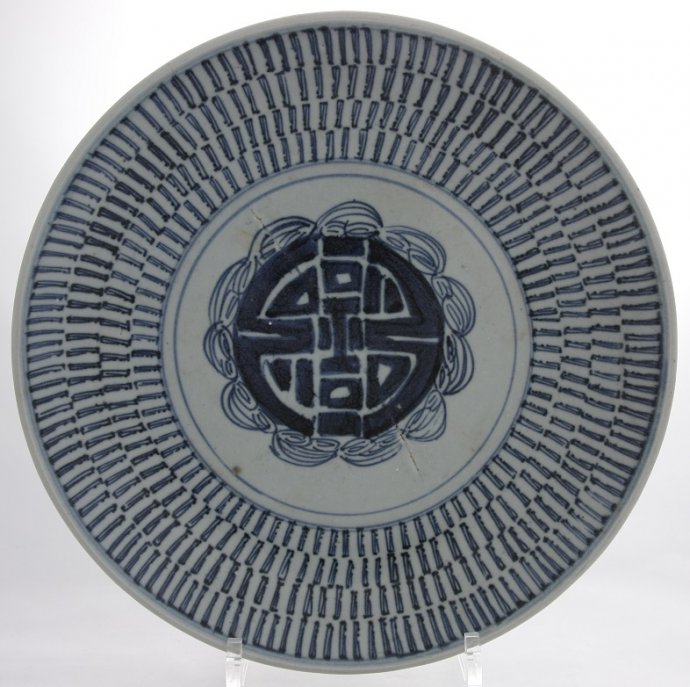
Sold Ceramics - Sold Shipwreck Porcelains - The Diana Cargo, 1817 - Page 1
Object 2010229
Dish
China
c.1816
Provenance: The Diana Cargo sale, Christie's Amsterdam, 6-7 March 1995
Height 55 mm (2.36 inch), diameter of rim 280 mm (11.02 inch), diameter of footring 165 mm (2.17 inch), weight 885 grams (31.22 ounce (oz.))
Dish on footring, straight rim and an unglazed base. Decorated in underglaze blue with a stylised "shou" character for long life surrounded by ruyi lappets and stylised Sanscrit "om" characters. On the dish the original 'Christie's Diana Cargo March 1995' sale lot 1284/72 label proving it has been one of 72 similar dishes sold in lot 1284.
The design on this dish is known as the 'Longevity' pattern. In total 1,880 dishes with the 'Longevity' design were sold over the lots: 374-416, 1158-1187, 1199-1209, 1224-1225, 1253-1255, 1278-1279, 1284-1288 & 1296-1297. (Amsterdam 1995)
Condition: Perfect.
Reference:
Price: Sold.
More pictures of object 2012103, another identically shaped, sized and decorated, sold, dish >>
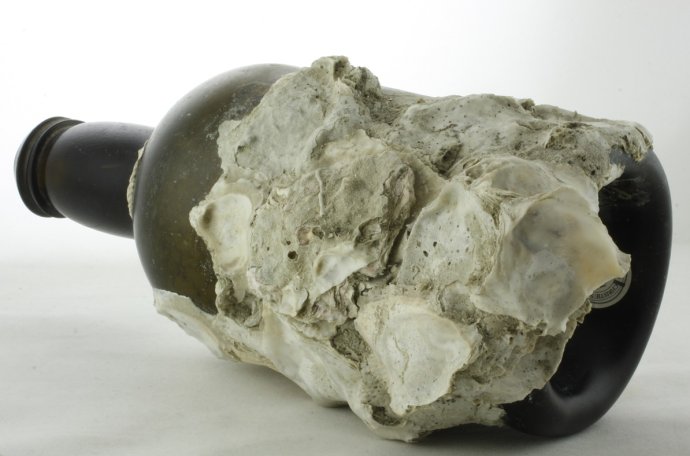
Sold Ceramics - Sold Shipwreck Porcelains - The Diana Cargo, 1817 - Page 1
Object 2011318
Port bottle
United Kingdom
c.1817
Provenance: The Diana Cargo sale, Christie's Amsterdam, 6-7 March 1995
Height 235 mm (9.25 inch), diameter 90 mm (3.54 inch), diameter of mouthrim 35 mm (1.38 inch), weight 907 grams (31.99 ounce (oz.))
A cylindrical shaped port bottle. On the bottle the original "Christie's Diana Cargo March 1995" sale label proving it has been one of 12 similar bottles sold in lot 1307.
Only the captain and his two officers would have taken alcohol, the "Lascar" crew being Muslim and teetotal, yet those three shared between them over 400 bottles of booze. (Ball 1995, p.122)
In total 199 port bottles were sold divided over the lots: 1298-1315. (Amsterdam 1995)
For an identical bottle, please see;
Condition: Perfect.
References:
Price: Sold.


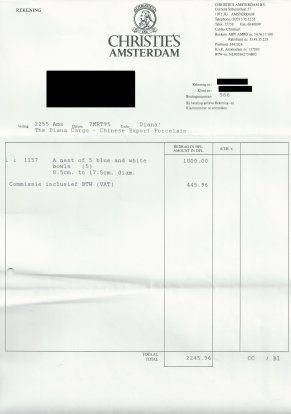
 create websites
create websites